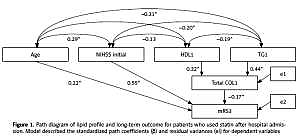Current issue
Archive
Manuscripts accepted
About the Journal
Editorial office
Editorial board
Section Editors
Abstracting and indexing
Subscription
Contact
Ethical standards and procedures
Most read articles
Instructions for authors
Article Processing Charge (APC)
Regulations of paying article processing charge (APC)
LIPID DISORDERS / CLINICAL RESEARCH
Extended lipid profile in Romanian ischemic stroke
patients in relation to stroke severity and outcome:
a path analysis model
1
CCAMF, George Emil Palade University of Medicine, Pharmacy, Science, and Technology of Targu Mures, Romania
2
3rd Department of Medical Informatics and Biostatistics, University of Medicine and Pharmacy “Iuliu-Ha-tieganu”, Cluj-Napoca, Romania
3
Department of Laboratory Medicine, George Emil Palade University of Medicine, Pharmacy, Science, and Technology of Targu Mures, Romania
4
George Emil Palade University of Medicine, Pharmacy, Science, and Technology of Targu Mures, Romania
5
Department of Neurology, George Emil Palade University of Medicine, Pharmacy, Science, and Technology of Targu Mures, Romania
6
Department of Pharmaceutical Biochemistry, Faculty of Pharmacy, George Emil Palade University of Medicine, Pharmacy, Science, and Technology of Targu Mures, Romania
Submission date: 2018-05-03
Final revision date: 2018-08-09
Acceptance date: 2018-08-17
Online publication date: 2019-10-23
Publication date: 2021-07-16
Arch Med Sci 2021;17(4):864-873
KEYWORDS
DHAischemic strokeNational Institutes of Health and Stroke Scale (NIHSS)stroke outcomemodified Rankin Scale (mRS)adrenic acid
TOPICS
ABSTRACT
Introduction:
Our aim was to evaluate the extended lipid profile in ischemic stroke patients and the relationship with stroke type, severity and outcome.
Material and methods:
We prospectively enrolled 124 ischemic stroke patients and 40 healthy controls; baseline plasma and erythrocyte membrane fatty acids concentrations and common lipid profile were analysed. Stroke severity was evaluated by NIHSS on admission, while the functional outcome was defined by mRS at discharge and after 3 months.
Results:
Total cholesterol, triglycerides, HDL-cholesterol, DHA, adrenic, stearic and lauric acid were all lower in patients, taking into account that 87.7% of patients did not receive statins before admission. There was a different pattern in plasma and erythrocyte membrane of fatty acids between patients and controls, also omega-3 index was significantly lower in patients. Patients with poor outcome without statins had significantly lower triglyceride (p = 0.028), while the total cholesterol levels were significantly lower in patients with poor outcome (p = 0.03) but with treatment initiated after admission. Bivariate analysis revealed that patients with poor outcome had significantly lower triglyceride levels regardless the statins use, while the total cholesterol and HDL-cholesterol levels were significantly lower in patients with poor outcome under statin treatment. The long-term outcome were positively influenced by age (β̂ = 0.22, p = 0.001), and NIHSS score at admission (β̂ = 0.55, p < 0.001), and negatively by cholesterol levels (β̂ = –0.17, p = 0.031).
Conclusions:
DHA, adrenic, stearic and lauric acid were lower in stroke patients; plasma adrenic acid was consumed during the acute phase. The most important predictors for long-term outcome was NIHSS at admission followed by age and total cholesterol.
Our aim was to evaluate the extended lipid profile in ischemic stroke patients and the relationship with stroke type, severity and outcome.
Material and methods:
We prospectively enrolled 124 ischemic stroke patients and 40 healthy controls; baseline plasma and erythrocyte membrane fatty acids concentrations and common lipid profile were analysed. Stroke severity was evaluated by NIHSS on admission, while the functional outcome was defined by mRS at discharge and after 3 months.
Results:
Total cholesterol, triglycerides, HDL-cholesterol, DHA, adrenic, stearic and lauric acid were all lower in patients, taking into account that 87.7% of patients did not receive statins before admission. There was a different pattern in plasma and erythrocyte membrane of fatty acids between patients and controls, also omega-3 index was significantly lower in patients. Patients with poor outcome without statins had significantly lower triglyceride (p = 0.028), while the total cholesterol levels were significantly lower in patients with poor outcome (p = 0.03) but with treatment initiated after admission. Bivariate analysis revealed that patients with poor outcome had significantly lower triglyceride levels regardless the statins use, while the total cholesterol and HDL-cholesterol levels were significantly lower in patients with poor outcome under statin treatment. The long-term outcome were positively influenced by age (β̂ = 0.22, p = 0.001), and NIHSS score at admission (β̂ = 0.55, p < 0.001), and negatively by cholesterol levels (β̂ = –0.17, p = 0.031).
Conclusions:
DHA, adrenic, stearic and lauric acid were lower in stroke patients; plasma adrenic acid was consumed during the acute phase. The most important predictors for long-term outcome was NIHSS at admission followed by age and total cholesterol.
Share
RELATED ARTICLE
We process personal data collected when visiting the website. The function of obtaining information about users and their behavior is carried out by voluntarily entered information in forms and saving cookies in end devices. Data, including cookies, are used to provide services, improve the user experience and to analyze the traffic in accordance with the Privacy policy. Data are also collected and processed by Google Analytics tool (more).
You can change cookies settings in your browser. Restricted use of cookies in the browser configuration may affect some functionalities of the website.
You can change cookies settings in your browser. Restricted use of cookies in the browser configuration may affect some functionalities of the website.



